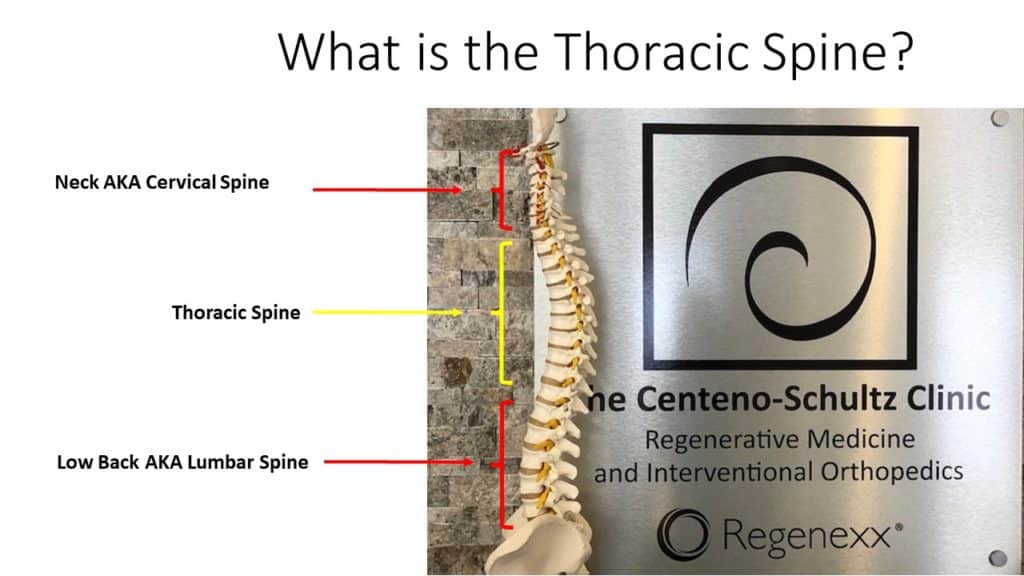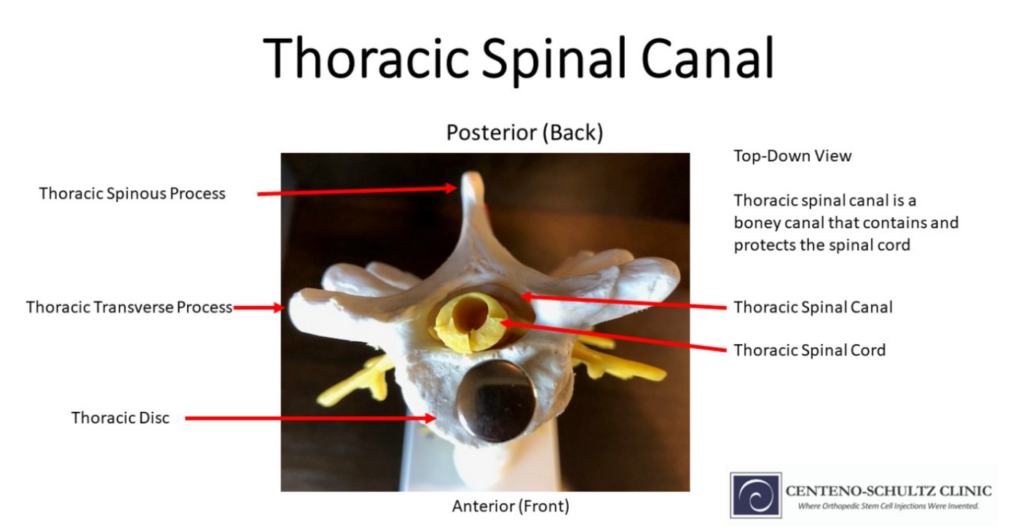The thoracic spine is a region of the spine that is located in the middle back. It is located below the cervical spine and above the lumbar spine. It is composed of 12 vertebrae that are numbered T1-12. The T denotes the thoracic spine. It has many important functions which are discussed below.
Location Of The Thoracic Spine
The spine, also known as the vertebral column, is a series of small bones called vertebrae that stack one upon another to form a strong column of bone. It extends from the base of the skull down to the pelvis.
The spine is divided into three sections: cervical spine (neck) lumbar spine (low back) and thoracic ( mid back). The thoracic spine is sandwiched between the neck and low back and provides many important functions that include protection of the spinal cord, thoracic spinal nerves and allows for movement and flexibility of the torso.
Thoracic Spine Anatomy And Function
The thoracic spine has many functions, like protecting the spinal cord, anchoring the ribs, supporting the abdomen and the chest, and allowing body movement. The thoracic spine’s anatomy is closely aligned with its functions.
Protects The Spinal Cord
The thoracic spine is a column of 12 bones stacked upon one another which are labeled T1-12. They form a hollow canal surrounded by bone called the spinal canal.
The spinal canal contains the spinal cord and thoracic spinal nerves both of which are both in a protective fluid called the cerebral spinal fluid. The thoracic spine provides important protection to the spinal cord and thoracic nerves.
Anchors The Ribs
There are 12 pairs of ribs that attach to the thoracic spine. Each rib connects to the transverse process of its corresponding thoracic vertebra. The ribs also connect anteriorly to the sternum also known as the chest plate with the exception of the eleventh and twelfth ribs which are floating. Since these two ribs do not attach to the sternum they are referred to as floating ribs.
Supports The Chest And Abdomen
The thoracic spine provides support to the chest and abdomen in several ways.
- The vertebral bodies that stack one upon another form a rigid column that helps maintain the shape of the torso.
- The ribs that attach to the thoracic spine provide protection for the vital organs in the chest cavity such as the heart and lungs.
- Muscles, tendons and ligaments of the thorax and abdomen attach to the thoracic spine providing stability and movement such as bending, twisting, and lifting.
- Critical role in breathing as the ribs attached to the thoracic spine move during inspriation and expiration, allowing for the expansion and contraction of the chest cavity.
Allows Body Movement
The thoracic spine allows body movement in many ways. The discs which are sandwiched between each vertebra act as shock absorbers that allow some movement of the thoracic spine. The facet joints enable flexion, extension, rotation, and lateral bending. Muscles, tendons, and ligaments that attach to the thoracic spine provide support and movement of the arms and shoulders.
How The Location Of The Thoracic Vertebrae Affects The Body
The thoracic spine has 12 vertebrae that stack one upon another which are numbered in T1-T12. Sandwiched between the vertebrae are shock absorbers called discs. At each level of the thoracic spine, nerves exit the spine. Each nerve provides important information to different parts of the body. These functions include:
T1 and T2 Nerves: Hands And Fingers
The T1 nerve helps with the movement and feeling in the shoulder, arm, and hand. The T2 nerve helps with the movement and feeling in the muscles and skin of the upper chest. Discuss how the T1 vertebrae affect the hands
T3 To T5: Chest Muscles
The intercostal muscles are located between your ribs and help with breathing by expanding and contracting the chest. The T2-T5 nerves provide information to the intercostal muscles. If there is an injury or misalignment at this level, it can affect T2-T5 nerve function and patients may complain of weakness in the upper chest or difficulty breathing.
T6 To T8: Chest And Abdominal Muscles
The T6-8 nerves provide information to the upper and lower abdominal muscles. The upper abdominal muscles are responsible for breathing and play a role in trunk flexion and stabilization. The lower abdominal muscles are responsible for trunk flexion, rotation, and stabilization of the pelvis. Injury or dysfunction of the T6-8 nerves can cause weakness and or pain in the abdominal muscles.
T9 To T12: Abdominal Muscles
The T9-12 nerves control the muscles and skin of the abdomen, back, and flank. They also contribute to the sympathetic nervous system which helps regulate many bodily functions such as heart rate and blood pressure.
Common Conditions That Affect The Thoracic Spine
The thoracic spine has many important roles that include protection of the spinal cord, anchoring the ribs, and supporting the abdomen and chest. The nerves that exit the thoracic spine provide important information to the skin, muscles, and the sympathetic nervous system. The thoracic spine is also susceptible to injury and wear and tear. This can result in a number of different conditions.
Thoracic Degenerative Disc Disease
Degenerative disc disease is a clinical condition that refers to the gradual deterioration of the discs located in the thoracic spine and the associated symptoms. Pain, weakness, muscle spasms, and restriction in range of motion are common. Degenerative disc disease can occur at each level of the spine: cervical, thoracic, and lumbar. Studies have demonstrated that degenerative disc disease in the thoracic spine most commonly occurs in the third to fourth decades (1) and occurs most frequently in the lower thoracic segments from T7-T12. Thoracic degenerative disc…
Read More About Thoracic Degenerative Disc DiseaseHerniated Thoracic Disc
A herniated thoracic disc is especially difficult because there are not as many treatments available as there are for disc herniations in other areas of the spine. To understand Thoracic Disc Herniations, though, we first need to cover thoracic spine anatomy and function. With disc herniation, the annulus fibrosus get small tears throughout the annulus. An annulus is a bunch of concentric fibers, so, as the fibers get damaged and cut, the pressure that is built up within the nucleus pushes the now weakened annulus outward, creating a bulge or herniation. The disc begins to weaken via mild degeneration/tearing of the annular fibers…
Read More About Herniated Thoracic DiscThoracic Radiculopathy
Thoracic radiculopathy is a painful medical condition that affects both men and women alike. Pain, paresthesia, decreased sensation, and weakness are the major symptoms. Radiculopathy refers to the whole complex of symptoms that can be caused by irritation or compression of a nerve root in the spine. Thoracic radiculopathy is irritation or compression of a thoracic spinal nerve. Causes of radiculopathy in the thoracic region are thoracic disc injuries, thoracic facet arthritis, ligament thickening, facet cyst, unstable rib attachments, and bone spurs. Diagnosis of thoracic radiculopathy can be difficult….
Read More About Thoracic RadiculopathyThoracic Outlet Syndrome
The thoracic outlet is an area around the collar bone where the nerves that come from your neck meet up with the blood vessels from your heart and together supply the entire upper extremity (shoulder and arm). These blood vessels (subclavian artery and vein) and nerves (brachial plexus) travel from the base of your neck to your armpit (axilla) and are considered the “thoracic outlet”. Now that you know what the thoracic outlet is, what is thoracic outlet syndrome? Simply listening to a patient’s history and completing a physical examination is all that is needed to diagnose TOS. But more involved imaging such as X-rays…
Read More About Thoracic Outlet SyndromeProvide Proper Care For Your Thoracic Spine
The thoracic spine is a region of the spine that is located in the middle back. It has many important functions that include protecting the spinal cord, anchoring the ribs, supporting the chest and abdomen, and movement. At each level of the thoracic spine, nerves exit supplying important information to specific areas.
The T1 nerve helps with the movement and feeling in the shoulder, arm, and hand. The T2 nerve helps with the movement and feeling in the muscles and skin of the upper chest.
Injuries in the thoracic spine can occur causing a number of different clinical conditions that include thoracic disc herniation, thoracic radiculopathy, thoracic outlet syndrome, and thoracic degenerative disc disease. Pain and dysfunction are common and can significantly compromise one’s well-being and function.
Unfortunately, thoracic pain is poorly understood and treated. At the Centeno-Schultz Clinic, we are experts in the evaluation and treatment of thoracic spine injuries.


